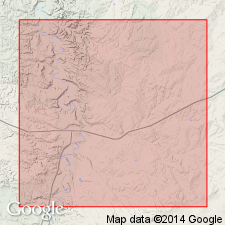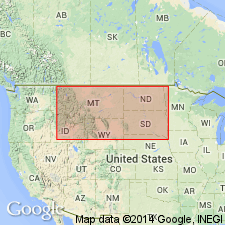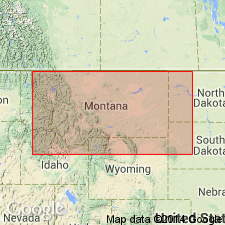
- Usage in publication:
-
- Mosby sandstone member
- Modifications:
-
- Named
- Dominant lithology:
-
- Limestone
- Sandstone
- AAPG geologic province:
-
- Williston basin
Summary:
Named as a member of the Colorado shale in the Cat Creek oil field, Fergus [now Petroleum Co] and Garfield Cos, MT in the Williston basin; named from Mosby post office in Garfield Co. No type locality designated. Occurs in the central northern part of MT as a distinct, easily recognized unit in the exposed part of the Colorado shale formation in region of Musselshell river. Is a sandstone, 3 to 4 ft thick that occurs 1,065 ft above base of Colorado and is divided into two approximately equal parts by a dirty fossiliferous limestone bed about 6 inches thick. Along the Musselshell river, forms a conspicuous rim rock at top of the bluffs bordering the river and has a uniform and unvarying character underlain by unnamed part of Colorado. Overlain by the Sage Hen sandy limestone (new) of Colorado shale. Geologic map. Composite section of the Colorado shale described. Of Late Cretaceous age.
Source: GNU records (USGS DDS-6; Denver GNULEX).

- Usage in publication:
-
- Mosby sandstone member*
- Modifications:
-
- Biostratigraphic dating
- Overview
- AAPG geologic province:
-
- Williston basin
Summary:
Is a member of the upper part of the Colorado shale in Blaine, Phillips, Garfield, and Petroleum Cos, MT in the Williston basin. In exposures near Mosby P.O. on the Musselshell River in east-central MT the Colorado shale is 1,930 ft thick, and the Mosby lies 743 ft below the top. Stratigraphic section, measured east of Musselshell River from 1/4 mi east to 1/2 mi north of Mosby P.O., in S1/2 sec 2 and N1/2 sec 11, T14N, R30E, Garfield Co, MT is recommended as the type section. Is chiefly light-gray fine- to very fine grained calcareous sandstone that commonly has a concretionary habit; ranges from massive to shaly in short distance and shows cross bedding and ripple marks; sandstone is hard and forms low ridge or hogback above the softer Colorado shale. At type locality, consists largely of two 5.5-ft-thick sandstone beds separated by 11 ft of sandy shale. Describes three new ammonite species, METOICOCERAS MOSBYENSE, M. MUELLERI, and DUNVEGANOCERAS PARVUM; and one new subspecies D. ALBERTENSE MONTANENSE. A very late Cenomanian age is assigned on basis of ammonites.
Source: GNU records (USGS DDS-6; Denver GNULEX).

- Usage in publication:
-
- Mosby Sandstone Member*
- Modifications:
-
- Revised
- AAPG geologic province:
-
- Williston basin
Summary:
Mosby Sandstone Member, basal member of Greenhorn Formation. Formerly a member of †Warm Creek Shale (herein abandoned); is reassigned to Greenhorn Formation (geographically extended into central and north-central Montana). Correlates with the "Phillips sand" (economic term) of subsurface usage.
Source: Changes in stratigraphic nomenclature, 1975 (USGS Bull. 1422-A, p. A28-A29, A66-A67).

- Usage in publication:
-
- Mosby Sandstone Member*
- Modifications:
-
- Overview
- Revised
- AAPG geologic province:
-
- Williston basin
- Sweetgrass arch
- Central Montana uplift
Summary:
Formerly the basal member of the Greenhorn Formation (here revised), is reassigned as the uppermost member of the Belle Fourche Shale (here revised) in the Williston basin and on Sweetgrass arch and Central Montana uplift. The Belle Fourche Shale-Greenhorn Formation contact is revised upward from the base of the Mosby Sandstone Member (where the Mosby occurs) to the top of noncalcareous shale that overlies the Mosby. Upper contact of the Mosby is stated to be the top of a unit of noncalcareous shale that overlies the sandstone beds and coincides with the top of the Belle Fourche Shale. Mosby is hereafter extended to include all sandstone beds developed in the Belle Fourche that are approximately confined to the upper 60 m; member also includes noncalcareous siltstone and shale between and above the sandstones. Geophysical logs of Mosby in north-central MT shown in fig. 22. Areal extent map of Mosby shown in fig. 21. [Age of Belle Fourche Shale and its Mosby Sandstone Member is incorrectly stated to be Cenomanian and Turonian; age is Cenomanian only.]
Source: GNU records (USGS DDS-6; Denver GNULEX).
For more information, please contact Nancy Stamm, Geologic Names Committee Secretary.
Asterisk (*) indicates published by U.S. Geological Survey authors.
"No current usage" (†) implies that a name has been abandoned or has fallen into disuse. Former usage and, if known, replacement name given in parentheses ( ).
Slash (/) indicates name conflicts with nomenclatural guidelines (CSN, 1933; ACSN, 1961, 1970; NACSN, 1983, 2005, 2021). May be explained within brackets ([ ]).

